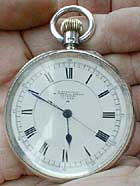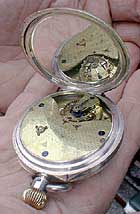

[Adkins team]
![]()
the Adkins team
 |
the Adkins team, left to right: John Greenwood, Helen Adkins, Hazel Cash-Davis and Malcolm Adkins |
Malcolm Adkins: lives in Gloucester Street in Coventry's Spon End, in a house originally built in 1878 by the watchmaker William
Wakelin. Today, Malcolm carries out conservation boat building
there.
Hazel Cash-Davis: Malcolm's partner, who works in Ely library.
Helen Adkins: Malcolm's daughter, editor of Traditional Woodworking magazine.
John Greenwood: Helen's husband, a solicitor.
The Adkins team was given a pocket watch with the inscription 'BONNIKSEN, NORFOLK STREET' (Norfolk Street backs on to Gloucester Street). On the back there is a number -- 56985 -- and an 'Admiralty arrow'. They had to find out who owned the watch and where it had been.
Malcolm also wanted to find out about the workings of the watchmaking trade and whether his theory -- that the watchmakers were a resilient community of independent artisans with little hierarchy -- was true.

the Adkins team watch

inside the Adkins team watch
how the team got on
Malcolm, Hazel, Helen and John were given a watch with 'BONNIKSEN, NORFOLK STREET' engraved on the back.
GREENWICH OBSERVATORY
Malcolm and Helen meet Jonathan Betts, curator of watches. He
shows them the Harrison watches (made famous by the book Longitude) and explains that the breakthrough by Harrison in making a clock
accurate enough to measure longitude was a major contributor to
the growth of the Coventry watchmaking industry; it also laid
the foundations for Britain's world domination through navigation.
In Coventry, deck watches were developed. From the late 1880s,
Greenwich conducted trials of watches and published the results;
a good one virtually guaranteed purchase of the watches by the
Admiralty.
Jonathan Betts shows Malcolm and Helen an index of chronometers containing the details of 50,000 watches. Malcolm looks in a card file under 'Bonniksen' and then cross-references this with the number on the watch: 56985. This leads to the ledger of trials. Bonniksen's watch -- which had a Karrusel movement -- did well and was purchased by the Admiralty.
HISTORY ROOM
Hazel and John look up 'Bonniksen' in trade directories and census
returns to find out where he lived and worked. From the census
returns, they discover that he was at No. 16 Norfolk Street, across
the street from Malcolm's house. The trade directory states that
Bonniksen was the inventor of the Karrusel movement; Hazel and
John look up his patent. In a book by the inventor, they find
out that one of his watches was on the ship that took Amundsen
to the South Pole.
GREENWICH OBSERVATORY
In the strong room, Hazel and Malcolm check out the 'ledgers of
the receipt of Admiralty' and find that their watch was on HMS
Victorious and the third HMS Dreadnought. They look up these ships in the Admiralty list to find out the
career of their watch.
HERBERT ART GALLERY & MUSEUM
Watch expert Alan Midleton tells the team how the Karrusel movement
worked and why it was so universally adopted.
HISTORY ROOM
The team trace the watchmakers who occupied Malcolm's house in
Gloucester Street by examining apprentice records, freemen's records,
house deeds and trade directories. A William Wakelin lived there
from 1872 to (probably) 1891, when an Edward Kirby moved in.
The team discover that Bonniksen had a partner named Kirby, but cannot discover if the occupant of Malcolm's house was the same person or even just related.
MUSEUM OF BRITISH ROAD TRANSPORT
The team go to the museum to have a look at a Bonniksen speedometer -- showing how the watchmaking industry eventually merged with
car and bicycle manufacture.